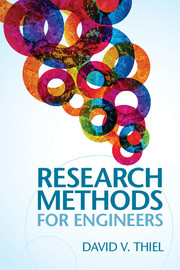Book contents
- Frontmatter
- Contents
- Preface
- An introductory note for instructors
- 1 Introduction to engineering research
- 2 Literature search and review
- 3 Developing a research plan
- 4 Statistical analysis
- 5 Optimization techniques
- 6 Survey research methods
- 7 Research presentation
- 8 The path forward
- Appendix A: Matlab plot functions
- Appendix B: Excel plot functions
- Index
- References
8 - The path forward
Published online by Cambridge University Press: 05 September 2014
- Frontmatter
- Contents
- Preface
- An introductory note for instructors
- 1 Introduction to engineering research
- 2 Literature search and review
- 3 Developing a research plan
- 4 Statistical analysis
- 5 Optimization techniques
- 6 Survey research methods
- 7 Research presentation
- 8 The path forward
- Appendix A: Matlab plot functions
- Appendix B: Excel plot functions
- Index
- References
Summary
A research project is about creativity. A research team can only exercise this creativity if they:
Know and understand their engineering discipline well;
Read the literature and continue to keep up to date with recent publications;
Maintain cordial relationships with colleagues and funding organizations;
Are honest and ethical in all aspects of the research process;
Plan and remain well organized;
Stick to the schedule if at all possible.
While the motivation to undertake research must be primarily to improve the human condition through the development of new engineering products and services, there are significant personal rewards for researchers through a published legacy of achievement which leads to reputation building and employment opportunities.
The engineering disciples continue to grow and change. So too do the methods of interacting with the general public and the application of new technologies to the research process and publication of results. As these new processes and technologies arise, professional engineers must maintain their ability to engage with new technology as well as to continue to contribute to these changes through published research.
- Type
- Chapter
- Information
- Research Methods for Engineers , pp. 267 - 284Publisher: Cambridge University PressPrint publication year: 2014



